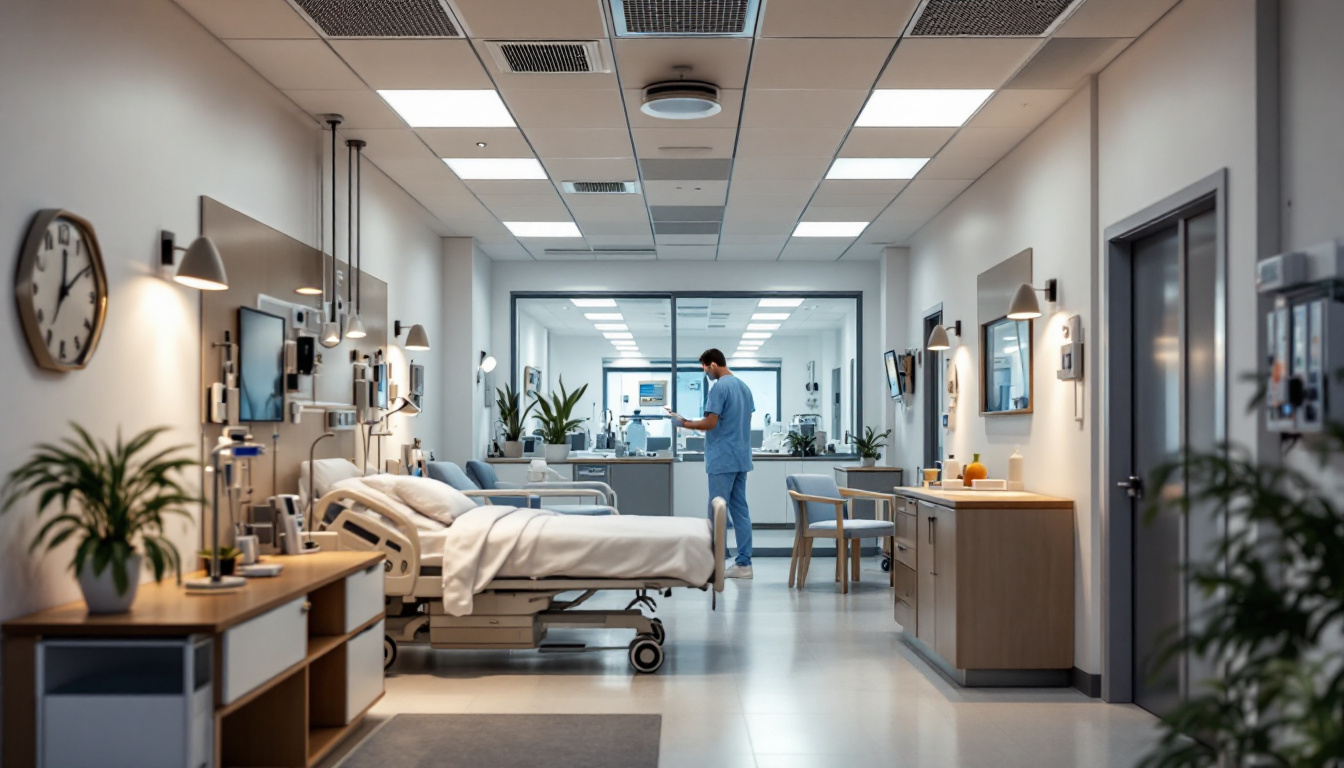
In the realm of healthcare, lighting plays a pivotal role in enhancing patient care, ensuring safety, and facilitating the efficient operation of medical facilities. For lighting contractors, understanding the unique requirements of hospital environments is essential. This article aims to provide valuable insights and practical advice for lighting contractors working within the healthcare sector.
Hospitals are complex environments that require specialized lighting solutions. Unlike typical commercial spaces, hospitals must accommodate various needs, from patient comfort to operational efficiency. Recognizing these challenges is the first step for contractors aiming to deliver effective lighting solutions.
One of the primary considerations in hospital lighting is patient comfort. Studies have shown that appropriate lighting can significantly affect a patient’s mood, anxiety levels, and overall experience. Soft, warm lighting in patient rooms can create a calming atmosphere, while brighter, cooler lighting may be necessary in areas such as operating rooms or examination areas.
Lighting contractors should consider the use of dimmable fixtures and adjustable color temperatures to cater to varying patient needs. This flexibility allows healthcare providers to create environments that promote healing and relaxation. Furthermore, the integration of circadian rhythm lighting, which mimics natural daylight patterns, can enhance sleep quality and overall well-being for patients, particularly in long-term care settings. By aligning lighting with the body’s natural rhythms, hospitals can foster a more restorative environment that supports recovery.
Safety is paramount in hospital settings. Proper lighting is essential for ensuring that staff can navigate the facility safely and efficiently. High-contrast lighting can help reduce accidents, especially in areas such as hallways, staircases, and emergency exits. Additionally, well-lit corridors and waiting areas can alleviate anxiety for patients and their families.
In critical areas like operating rooms, lighting must be bright and focused to provide surgeons with the visibility they need for intricate procedures. Understanding the specific lighting requirements for different hospital zones is crucial for contractors. Moreover, the implementation of emergency lighting systems that activate during power outages or crises is vital for maintaining safety and ensuring that all personnel can respond effectively in urgent situations. These systems must be strategically placed to guide individuals to safety without causing panic or confusion.
As healthcare facilities strive to reduce their environmental footprint, energy-efficient lighting solutions have become increasingly important. Contractors should be well-versed in the latest technologies, such as LED fixtures, which offer significant energy savings and longer lifespans compared to traditional lighting options.
Incorporating smart lighting systems that adjust based on occupancy or natural light levels can further enhance energy efficiency. These systems not only reduce costs but also contribute to a more sustainable healthcare environment. Additionally, hospitals can benefit from integrating daylight harvesting techniques, which utilize natural light to reduce reliance on artificial lighting during the day. This approach not only lowers energy consumption but also creates a more pleasant atmosphere for patients and staff, reinforcing the connection between nature and well-being. As hospitals continue to evolve, the focus on sustainable lighting solutions will play a critical role in shaping the future of healthcare design.
Designing a lighting system for a hospital requires careful planning and consideration of various factors. From compliance with regulations to the specific needs of different departments, contractors must navigate a complex landscape.
Hospitals must adhere to strict regulations regarding lighting, which can vary by region. Familiarity with codes and standards, such as those set by the Illuminating Engineering Society (IES) and the American National Standards Institute (ANSI), is essential for contractors. Compliance not only ensures safety but also protects the facility from potential legal issues.
Additionally, contractors should be aware of the specific lighting requirements for different areas within the hospital, such as patient rooms, waiting areas, and surgical suites. Each zone has its own standards that must be met to ensure optimal functionality and safety. For instance, surgical suites require high-intensity lighting with adjustable color temperatures to allow for precise visibility during procedures, while patient rooms benefit from softer, warmer lighting that promotes relaxation and healing.
Effective communication and collaboration with healthcare professionals are vital during the design and installation phases. Lighting contractors should engage with doctors, nurses, and facility managers to understand their specific needs and preferences. This collaboration can lead to more tailored lighting solutions that enhance both patient care and operational efficiency.
Feedback from healthcare staff can provide valuable insights into how lighting affects their workflow and patient interactions. By incorporating their input, contractors can create lighting systems that not only meet regulatory standards but also improve the overall hospital experience. For example, adjustable lighting in patient rooms can help staff monitor patients more effectively, while also allowing patients to control their own environment, fostering a sense of autonomy and comfort.
Modern hospitals are increasingly integrating advanced technologies into their operations. Lighting contractors should be prepared to incorporate smart lighting systems that can be controlled remotely or programmed to adjust based on specific needs. These systems can enhance energy efficiency and provide greater flexibility in managing lighting throughout the facility.
Additionally, the integration of lighting with other systems, such as HVAC and security, can create a more cohesive and efficient environment. Contractors should stay informed about the latest technological advancements and consider how they can be applied within hospital settings. For instance, utilizing occupancy sensors can help reduce energy consumption by ensuring that lights are only on when spaces are in use, while also enhancing safety by providing adequate illumination in emergency situations. Furthermore, the use of circadian lighting systems, which mimic natural daylight patterns, can significantly improve patient recovery times and staff well-being by regulating sleep cycles and enhancing mood.
Each area of a hospital has unique lighting requirements that must be addressed to ensure optimal functionality and comfort. Understanding these needs is crucial for lighting contractors aiming to deliver effective solutions.
In patient rooms, the focus should be on creating a soothing and comfortable environment. Soft, adjustable lighting can help patients relax and promote better sleep. Dimmable fixtures, bedside reading lights, and natural light sources can enhance the overall experience.
Consideration should also be given to the placement of lighting fixtures to minimize glare and shadows, which can be disorienting for patients. The goal is to create a space that feels welcoming and promotes healing.
Operating rooms require specialized lighting that provides bright, focused illumination. Surgical lighting should be adjustable to allow for precise control during procedures. Additionally, the color temperature of the lighting should be carefully considered to ensure accurate color representation for surgeons.
Lighting contractors must also account for the need for shadow-free illumination, as shadows can interfere with delicate surgical tasks. Utilizing advanced lighting technologies, such as LED surgical lights, can enhance visibility and improve outcomes in these critical environments.
The emergency department is a high-stress environment where quick decisions are essential. Lighting in these areas should be bright and efficient to facilitate rapid assessments and treatments. High-contrast lighting can help staff quickly identify patients and navigate the space effectively.
In addition to functional lighting, the design should also consider the emotional impact on patients and their families. Incorporating softer lighting in waiting areas can help alleviate anxiety, while ensuring that treatment areas are adequately illuminated for medical staff.
Once a lighting system is installed, ongoing maintenance is crucial to ensure optimal performance and longevity. Contractors should provide guidance on maintenance practices and schedules to hospital staff.
Regular inspections of lighting fixtures are essential to identify any issues before they become significant problems. This includes checking for burnt-out bulbs, malfunctioning sensors, and general wear and tear. Establishing a routine maintenance schedule can help prolong the lifespan of the lighting system and ensure consistent performance.
Additionally, contractors should educate hospital staff on how to perform basic maintenance tasks, such as replacing bulbs and cleaning fixtures. Empowering staff with this knowledge can lead to quicker resolutions and minimize downtime.
As technology continues to evolve, hospitals may benefit from upgrading their lighting systems to incorporate the latest advancements. Contractors should stay informed about emerging technologies and offer recommendations for upgrades that can enhance energy efficiency and functionality.
Implementing upgrades can also improve the overall patient experience and contribute to a more sustainable healthcare environment. Contractors should work collaboratively with hospital management to identify opportunities for enhancement.
Hospital lighting is a critical aspect of healthcare that significantly impacts patient care, staff efficiency, and overall facility operations. For lighting contractors, understanding the unique challenges and requirements of hospital environments is essential for delivering effective solutions.
By focusing on patient comfort, safety, energy efficiency, and regulatory compliance, contractors can create lighting systems that enhance the healthcare experience. Collaboration with healthcare professionals and staying informed about technological advancements will further empower contractors to provide innovative and effective lighting solutions.
As the healthcare landscape continues to evolve, the role of lighting contractors will remain vital in shaping environments that promote healing, safety, and well-being. Embracing these principles will not only benefit hospitals but also contribute to the overall advancement of healthcare as a whole.
Ready to elevate your hospital lighting projects with the best in spec-grade lighting products? Look no further than LumenWholesale. Our commitment to quality, affordability, and convenience ensures that you have access to the most reliable lighting solutions at wholesale prices. Say goodbye to middleman markups and hello to a vast selection of industry-standard lighting that will transform any healthcare environment. Plus, with free shipping on bulk orders, you can trust that you’re getting premium value without any hidden costs. Enhance your lighting installations with the efficiency and excellence that LumenWholesale provides. Wholesale Lighting at the Best Value is just a click away.

Discover the essential details about Type B bulbs that every lighting contractor needs to know.

Discover the common pitfalls lighting contractors face when selecting light switch types.

Discover the must-have tools and techniques for lighting contractors in “Lamppole: Essentials for Lighting Contractors.” This guide illuminates the key components and innovative solutions that ensure successful and efficient lighting projects.

Discover how LED lighting can transform your business’s bottom line.